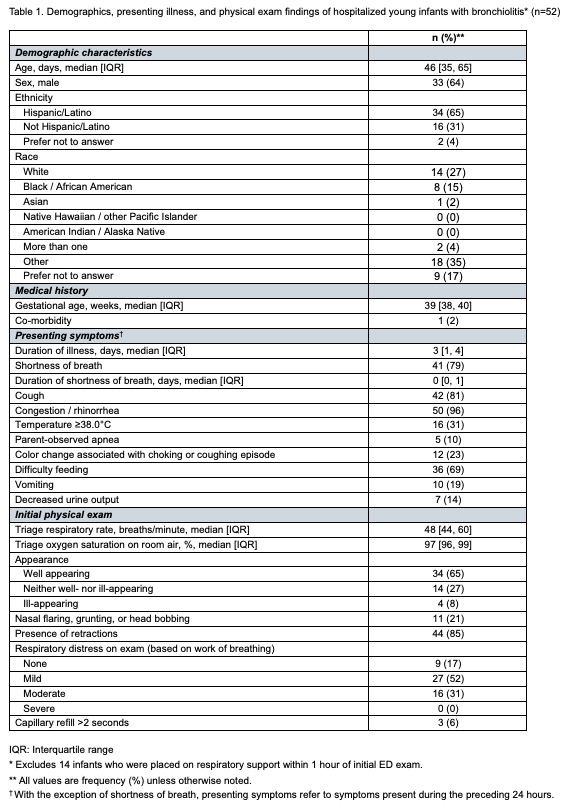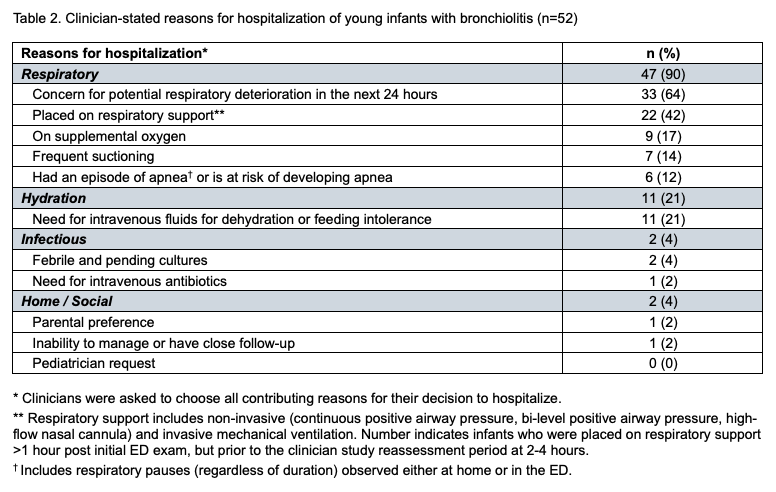Emergency Medicine
Session: Emergency Medicine 9: Respiratory
228 - Reasons for Hospitalization of Young Infants with Bronchiolitis
Monday, May 6, 2024
9:30 AM - 11:30 AM ET
Poster Number: 228
Publication Number: 228.3327
Publication Number: 228.3327

Son H. McLaren, MD, MS
Assistant Professor of Pediatrics (in Emergency Medicine)
Columbia University Vagelos College of Physicians and Surgeons
New York, New York, United States
Presenting Author(s)
Background: Bronchiolitis is a leading cause of hospitalizations in young infants (defined as ≤90 days old). There are sparse data on reasons for hospitalization and clinical course in this age group. Understanding dominant reasons may help reduce potentially unnecessary hospitalizations.
Objective: To identify clinicians’ reasons for hospitalization of young infants and the clinical course of these infants
Design/Methods: We are conducting a single-center prospective cohort study of infants ≤90 days old presenting to the pediatric emergency department (ED) with clinical diagnosis of bronchiolitis. Infants are excluded if they have 1) prior to development of bronchiolitis, use of oxygen or respiratory support at home or 2) were hospitalized for the same illness within the prior week. We excluded from the current analysis infants discharged home from the ED, as well as those initiated on respiratory support within 1 hour of initial ED exam, for whom there is clearer need for hospitalization at the time of ED presentation. Clinicians completed standardized data forms, documenting symptoms, exam findings, and their clinical management decisions 2-4 hours after the initial ED exam, including reasons for hospitalization (based on a comprehensive list of choices, with the ability for free text responses). ED and hospital course were reviewed using the electronic medical records.
Results: From 11/2021 to 07/2023, we enrolled 102 young infants. Of 66 (65%) who were hospitalized, 52 (79%) were not initiated on respiratory support within 1 hour (Table 1). The most common clinician-reported reasons for hospitalization for these 52 infants were respiratory related (90%), followed by dehydration (11%) (Table 2). Concern for concomitant bacterial infection and social reasons (e.g., difficulty with follow-up) were uncommon ( < 4% each). Of 33 infants hospitalized with concern for potential respiratory deterioration, 16 (49%) were never placed on any respiratory support, none were intubated, and 20 (61%) were managed with floor-level care (Table 3). Of 22 infants placed on respiratory support within 4 hours of initial ED exam, median duration of use was 3 days [IQR 2, 6]. No infants with parent- or ED-observed apnea experienced in-hospital apnea.
Conclusion(s): Concern for respiratory deterioration is the dominant reason for hospitalization in young infants with bronchiolitis. However, in-hospital apnea and use of invasive mechanical ventilation are uncommon. Clinical prediction models to accurately predict respiratory course may help reduce potentially unnecessary hospitalizations.


.png)
